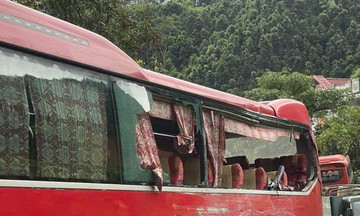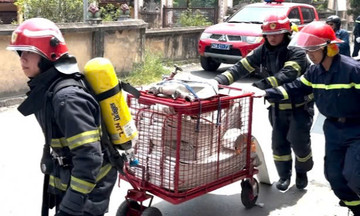 |
The 10-kilometer crescent-shaped Mui Ne bay, stretching from Ong Dia rock to Bo De fishing port, is home to hundreds of resorts, hotels, restaurants, and eateries. This area, considered the heart of former Binh Thuan (now Lam Dong) tourism, was once known as a "vacation paradise" for its warm climate, idyllic coconut groves, and pristine sandy beaches. |
 |
However, Mui Ne is losing its former charm as the coastline becomes increasingly altered, losing its untouched beauty. |
 |
Dozens of temporary seawalls, built by tourism businesses, line Mui Ne beach. These structures, formed by specialized fabric tubes filled with sand, create soft barriers over 20 meters long and 1.5 meters high, designed to protect the properties from waves. |
 |
A massive soft seawall, perpendicular to the shore and extending over 20 meters into the water, sits in front of a resort. |
Massive seawalls stand in front of resort beaches. Tourists hoping to stroll along the shore now face an obstacle course, forced to climb over these "walls" to move between resorts.
"The makeshift seawalls jutting out haphazardly make me feel unsafe when going for a swim," said Luu Hao, a tourist from Ho Chi Minh City. He hopes local authorities and the tourism community can find a comprehensive solution to preserve the natural beauty of this popular destination.
 |
Similar temporary barriers made of fabric, concrete, and rock cages have been constructed by resorts along the beach. These structures, placed parallel to the shore, aim to protect the properties from strong waves. |
 |
To Van Phu, 41, a Mui Ne resident, noted that over the past decade, changing weather patterns have led to increasingly stronger waves eroding the beaches. "To cope, resorts have been scrambling to build their own seawalls, each in their own way, making the beach look messy and unattractive," Phu said. |
 |
 |
 |
Nguyen Van Khoa, Chairman of the Binh Thuan Tourism Association, explained that facing coastal erosion, many establishments have had to urgently invest billions of dong in temporary seawalls to protect their properties and the remaining beach, enabling them to continue operating and welcoming tourists.
"However, due to the lack of a comprehensive solution for the entire area, each resort has built its own version, resulting in a lack of uniformity," Khoa said.
 |
According to the Lam Dong Provincial People's Committee, the Department of Agriculture and Environment issued detailed technical guidelines for constructing temporary sandbag seawalls for tourism establishments in Ham Tien - Mui Ne, effective from July. Resorts must adhere to these guidelines to ensure uniformity when building temporary seawalls.
In addition, the provincial Department of Science and Technology is conducting research on the causes of erosion and proposing solutions for coastal protection and beach enhancement in the Mui Ne - Ong Dia Rock - Phu Hai area, to be completed by the end of 2026. Based on the research findings, authorities will propose comprehensive solutions for long-term beach restoration, ensuring both aesthetics and a positive tourism environment.
Viet Quoc












